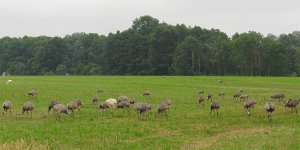I just read in a publication about cat C species in Germany that they assume it is unlikely that this species could get self sustaining populations in Europe. But theoretically it could be established earliest in 2019. That is based on the population in Northrhine-Westphalia where the species breeds annually since 1995 and the actual population size is estimated on up to 20 breeding pairs.
The publication is linked here:
http://www.club300.de/publications/index10.php
But it is written in German and if the WP Big Yearers doesn't like to go to Germany for such a stunning species as Black-browed Albatross there is no reason at all to visit German language for Wood Duck et al...
There's also a newer publication with a new way to assess if a bird is naturalised here
Bauer H-G, Geiter O, Homma S & Woog F 2016: Non-native bird species in Germany – revision of national status categories. Vogelwarte 54: 165-179.
Currently we have the following category C species on our national list:
Black Swan as C1 and C5 (ringed bird from dutch population), established 2004
Snow Goose as C1 and D, established 2011
Bar-headed Goose as C1 and probably C5, established ~2005
Canada Goose as C1 and C5, established 1981
Ruddy Shelduck as C1 and C5, established ~2001
Egyptian Goose as C1 and C5, established ~2010
Mandarin Duck as C1 and possibly C5, established 1985
Common Pheasant as C1, established ~1750
Rock Pigeon as C1 and probably C4, established prior 1500
Rose-ringed Parakeet as C1, established 1993
Alexandrine Parakeet as C1, established 2012
Yellow-headed Parrot as C1, established 2010
(Whooper Swan, Mute Swan, Greylag Goose, Barnacle Goose, Red-crested Pochard, Ferruginous Duck and other geese and ducks in A and C2)
Swan Goose as C4, established 2016
Ruddy Duck as C5, established in GB, F, NL
African Sacred Ibis as C5, established in F, I (however no record securely assignable to any of the established populations, thus categorization heavily criticized)
Currently in category E1
Greater Rhea, will become established 2025
Wood Duck, will become established in 2019
Greater Flamingo, established under time and generation criteria in 2012 but population of 2-3 pairs too small and survival only due to human help (electrical fence, agradation control)
Chilean Flamingo, established under time and generation criteria in 2013 but population of 5-8 pairs too small and survival only due to human help (electrical fence, agradation control)






